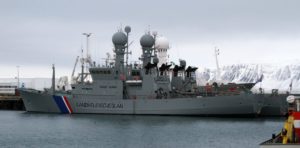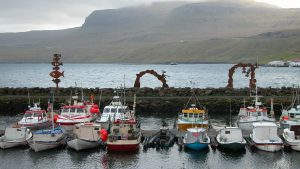Iceland
Facts & Figures
AC member since 1996
Active Polar Icebreakers
0
Coordinates
Reykjavík: 64.1265° N, 21.8174° W
Akureyri: 65.4100° N, 18.0516 W
Population
393,396
Land Area
103,000 km2
Coastline
4,970 km
- Environment
- People
- Economy
- Arctic Policy
- Recent Publications
- Links
- Experts
The majority of Iceland’s land mass sits just south of the Arctic Circle, with only the small island of Grímsey located partially inside the Arctic Circle. The country’s physical landscape is a mix of barren fields, rich agricultural lands, and stark peaks. The high amounts of precipitation and generally warmer weather than other areas at its latitude is due to its place in the Atlantic Ocean’s Gulf Stream. Average annual precipitation ranges from 400 to 4000 mm, with averages of 3000 mm on the south coast of the island.
Iceland, an island country in between the North Atlantic and Arctic Oceans, sits atop the northern Mid-Atlantic Ridge. Its position on the Ridge results in extensive volcanic and geothermal activity. Most of the country is a recently created mountainous lava desert, with the highest elevation at 2,110 meters (6,923 feet) above sea level. Just over 10 percent of the island is covered by glaciers, though these are now rapidly retreating due to climate change. Most of Iceland remains unpopulated, with the vast majority of its population residing in a ring along the coast. Twenty percent of the main island is used for grazing, while one percent is cultivated. The majority of Iceland’s population resides in the capital region in the southwest corner of Iceland: made up of six local governments: Reykjavík, Kópavogur, Garðabær, Seltjarnarnes, Mosfellsbær and Hafnarfjörður. Residents of these six communities account for 60 percent of the country’s entire population.
Despite only having a population of slightly more than 376,000, in 2022 more than two million people visited the island. While bringing a significant boom to the Icelandic economy after the 2008 Icelandic financial crisis, this tourism has brought environmental concerns with it. The government of Iceland, the tourism industry, and a growing body of academic researchers have dedicated much time, thought, and energy in ensuring that nature conservation efforts are not jeopardized by such a large increase in annual visitors. Building tourist infrastructure in an already saturated housing market, developing wilderness areas as tourist resorts, damaging moss-covered geographies, and the breaking of recent volcanic features are just a few examples of how tourism is changing the Icelandic landscapes and having an impact on its environment.
Increased energy production from hydroelectric and geothermal sources has also put pressure on Iceland’s natural landscape, demanding more dams to be built across streams, rivers, and estuaries and wilderness areas to be reclaimed for geothermal plants. Geothermal plants emit hydrogen-sulphide, which is both corrosive and toxic. Hydrogen sulphur does not necessarily lead to any specific diseases; but it does cause complications for those already suffering from serious illness. It must be acknowledged that Iceland’s dedication to renewable energy sources has made it a global leader in clean energy and one of the lowest energy sector greenhouse gas emitters. However, Iceland has seen an increase since 1990 in its greenhouse gas emissions from its industrial and transport sectors.
Iceland also has significant issues of soil erosion and desertification due to its high content of volcanic ash. Today nearly one third of the country is desert, though when the Vikings first settled the island, it was lush with trees, shrubs, and grass. The introduction of sheep, deforestation, and human settlement by Iceland first settlers, in addition to frequent volcanic eruptions, glacial river floods, and katabatic winds, has led to the landscape of ice and fire that Iceland is known for today. The Icelandic government has taken action against soil erosion and desertification since 1895, and has established the Soil Conservation Service of Iceland to combat desertification and promote sustainable land use.
The health of the ocean is of great importance to Iceland as an island nation. Therefore, Iceland imbues great importance into maintaining a healthy ocean environment and to ensure sustainable utilization of the ocean as one of the core sectors of Iceland’s economy. Iceland’s policies for ocean management and conservation are based on the UN Law of the Sea, which the country ratified in 1985; the concept of sustainable development, and the view that responsibility for the conservation and utilization of marine ecosystems is best placed in the hands of those states directly affected by the decisions taken and with the greatest interests at stake. Perhaps the largest environmental marine issue for Iceland is the sustainable harvesting of fish and other living marine resources. Opposition to the EU Common Fisheries Policy led in large part to the decision of a new right-of centre government to discontinue Iceland’s membership bid to the European Union in 2013. Despite being a fishing country with a focus on sustainable use of the ocean, Iceland is generally not regarded as an Arctic Ocean littoral State as its Exclusive Economic Zone (EEZ) is not adjacent to the high seas portion of the Central Arctic Ocean.
This page was updated on 10 January 2025. If we have missed anything, please contact info@thearcticinstitute.org.


